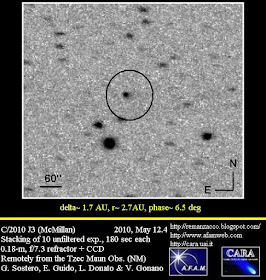Comet C/2009 R1 has been discovered in September 2009 by Robert H. McNaught in the course of Australia’s Siding Spring Survey.
For more information about the discovery of this comet, please see our previous post:
http://remanzacco.blogspot.com/2009/09/new-comet-discovery-c2009-r1-mcnaught.html
The comet is now around magnitude 7.5 and it will be a nice binocular object. Throughout this apparition it will be low in the east or northeast when dawn begins to brighten.
In our images, taken on May 26, is clearly visible a nice disconnection event (DE) in the plasma tail of the comet C/2009 R1. Occasionally due to comet-solar wind interaction, the entire plasma tail or part of it separates from the comet and drift away (antisunward), followed by simultaneous renewal of the plasma tail. This phenomena is called a disconnection event.

Here & here you can see bigger versions of this image:
Wide-field animation of comet C/2009 R1 (May 26, 2010), showing the DE event:
Wide-Field Image (May 26, 2010):

by Ernesto Guido & Giovanni Sostero







